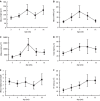Morphology and ontogeny of dendritic cells in rats at different development periods
- PMID: 19291826
- PMCID: PMC2658855
- DOI: 10.3748/wjg.15.1246
Morphology and ontogeny of dendritic cells in rats at different development periods
Abstract
Aim: To study the morphology and ontogeny of dendritic cells of Peyer's patches in rats at different development periods.
Methods: The morphometric and flow cytometric analyses were performed to detect all the parameters of villous-crypts axis and the number of OX62(+)DC, OX62(+)CD4(+)SIRP(+)DC, and OX62(+)CD4(-)SIRP(-)DC in the small intestine in different groups of rats. The relationship between the parameters of villous-axis and the number of DC and DC subtype were analyzed.
Results: All morphometric parameters changed significantly with the development of pups in the different age groups (F = 10.751, 12.374, 16.527, 5.291, 3.486; P = 0.000, 0.000, 0.000, 0.001, 0.015). Villous height levels were unstable and increased from 115.24 microm to 140.43 microm as early as 3 wk postpartum. Villous area increased significantly between 5 and 7 wk postpartum, peeked up to 13817.60 microm(2) at 7 wk postpartum. Villous height and crypt depth ratios were relatively stable and increased significantly from 2.80 +/- 1.01 to 4.54 +/- 1.56, 9-11 wk postpartum. The expression of OX62(+)DC increased from 33.30% +/- 5.80% to 80% +/- 17.30%, 3-11 wk postpartum (F = 5.536, P = 0.0013). OX62(+)CD4(+)SIRP(+)DC subset levels detected in single-cell suspensions of rat total Peyer's patch dendritic cells (PP-DCs) increased significantly from 30.73% +/- 5.16% to 35.50% +/- 4.08%, 5-7 wk postpartum and from 34.20% +/- 1.35% to 43.60% +/- 2.07% 9-11 wk postpartum (F = 7.216, P = 0.005).
Conclusion: This study confirms the age-related changes in villous-crypt axis differentiation in the small intestine. Simultaneously, there are also development and maturation in rat PP-DCs phenotypic expression. Furthermore, the morphological changes of intestinal mucosa and the development of immune cells (especially DC) peaked at 9-11 wk postpartum, indicating that the intestinal mucosae reached a relatively mature state at 11 wk postpartum.
Figures




References
Publication types
MeSH terms
LinkOut - more resources
Full Text Sources
Research Materials
Miscellaneous

